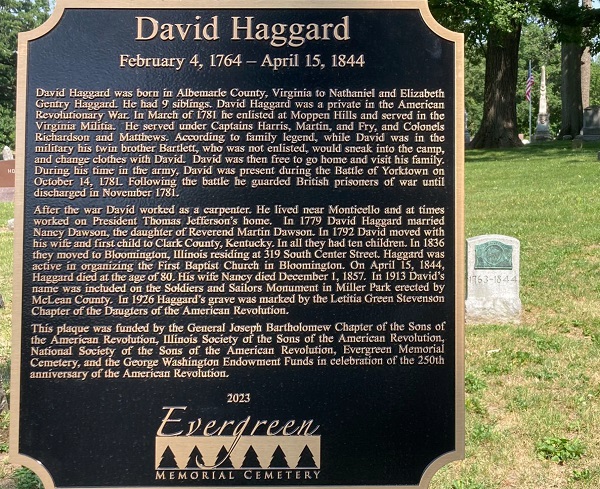David HAGGARD
SAR Patriot #:
P-172279
The following information was assembled from numerous sources and cannot be used directly as proof of Qualifying Service or Lineage.
It is considered a research aid and is intended to assist in locating sources that can be used as proof.
State of Service: VA
Qualifying Service: Private
DAR #: A049108
Birth: 04 Feb 1764 / Albemarle / VA
Death: 1843 Bloomington / McClean / IL
Qualifying Service Description:
- March 1781, enlisted in the company of Captain John Harris, commanded by Colonel Holt Richeson of the Virginia Militia
- Drafted into the company of Captain John Martin, commanded by Colonel Richeson and was later attached to Colonel Sampson Matthews
- In late 1781, he served in the company of Captain Joshua Fry
Additional References:
- Rev War Pension file R4429V
- Soldiers of the American Revolution Buried in Illinois, pg 94
- DAR Patriot Index, pg 293
Spouse: Nancy Dawson
Children: Dawson; Elizabeth; Mahala; Sally;
Members Who Share This Ancestor
| Date Approved | Society | ACN | SAR Member Info | Lineage via Child | View Application Detail | |
|---|---|---|---|---|---|---|
| 1993-03-10 | KY | Unassigned | William Thomas Turner (122342) | Louisa | ||
| 2024-03-22 | KS | 108177 | John William Forbes (130043) | Cynthia | ||
| 2024-03-22 | KS | 108178 | Bradley William Forbes (157782) | Cynthia |
Location:
Bloomington / McLean / IL / USA
Find A Grave Cemetery #:
Grave Plot #:
Section G, lot 684
Grave GPS Coordinates:
Find A Grave Memorial #:
Marker Type:
SAR plaque; DAR;
SAR Grave Dedication Date:
11 Jun 2023
Comments:
- Image taken and submitted by Compatriot Stephen R Kern (IL) member number 209690.
- The Find-a-Grave memorial shows photographic evidence of an original stone, presumed lost, for the Patriot that appears to be contemporary with the death of the Patriot. The cemetery was started as a small family cemetery in 1831, but was made a public cemetery in 1851 (after the death of the Patriot). This raises the question of what cemetery the original stone was in in 1844)
- There is currently a granite marker with a bronze plaque placed by the local DAR chapter
Directions to Cemetery / Gravesite:
